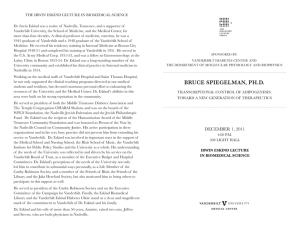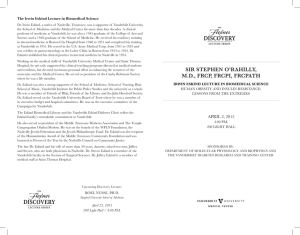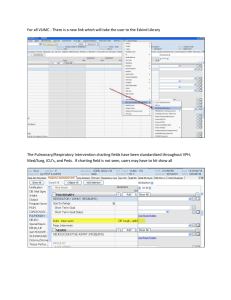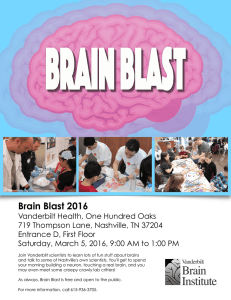The IrwIn eskInd LecTure In BIomedIcaL scIence
advertisement
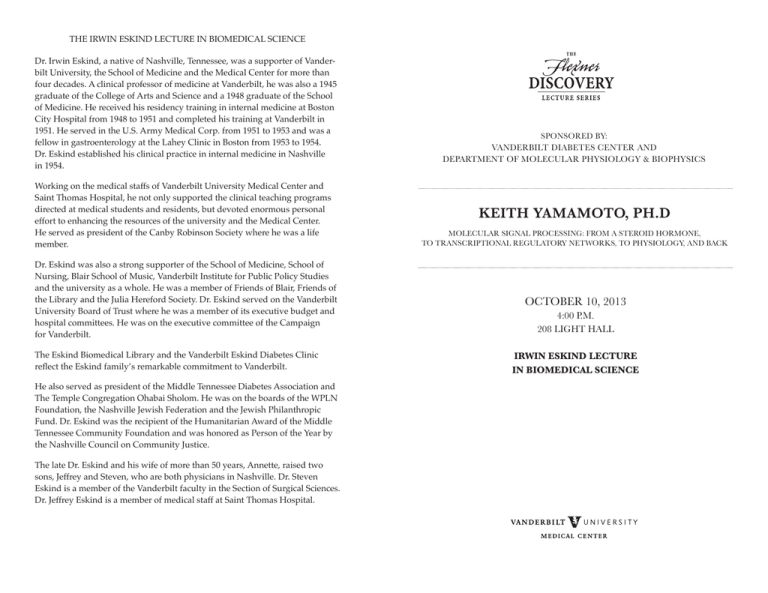
The Irwin Eskind Lecture in Biomedical Science Dr. Irwin Eskind, a native of Nashville, Tennessee, was a supporter of Vanderbilt University, the School of Medicine and the Medical Center for more than four decades. A clinical professor of medicine at Vanderbilt, he was also a 1945 graduate of the College of Arts and Science and a 1948 graduate of the School of Medicine. He received his residency training in internal medicine at Boston City Hospital from 1948 to 1951 and completed his training at Vanderbilt in 1951. He served in the U.S. Army Medical Corp. from 1951 to 1953 and was a fellow in gastroenterology at the Lahey Clinic in Boston from 1953 to 1954. Dr. Eskind established his clinical practice in internal medicine in Nashville in 1954. Working on the medical staffs of Vanderbilt University Medical Center and Saint Thomas Hospital, he not only supported the clinical teaching programs directed at medical students and residents, but devoted enormous personal effort to enhancing the resources of the university and the Medical Center. He served as president of the Canby Robinson Society where he was a life member. Dr. Eskind was also a strong supporter of the School of Medicine, School of Nursing, Blair School of Music, Vanderbilt Institute for Public Policy Studies and the university as a whole. He was a member of Friends of Blair, Friends of the Library and the Julia Hereford Society. Dr. Eskind served on the Vanderbilt University Board of Trust where he was a member of its executive budget and hospital committees. He was on the executive committee of the Campaign for Vanderbilt. The Eskind Biomedical Library and the Vanderbilt Eskind Diabetes Clinic reflect the Eskind family’s remarkable commitment to Vanderbilt. He also served as president of the Middle Tennessee Diabetes Association and The Temple Congregation Ohabai Sholom. He was on the boards of the WPLN Foundation, the Nashville Jewish Federation and the Jewish Philanthropic Fund. Dr. Eskind was the recipient of the Humanitarian Award of the Middle Tennessee Community Foundation and was honored as Person of the Year by the Nashville Council on Community Justice. The late Dr. Eskind and his wife of more than 50 years, Annette, raised two sons, Jeffrey and Steven, who are both physicians in Nashville. Dr. Steven Eskind is a member of the Vanderbilt faculty in the Section of Surgical Sciences. Dr. Jeffrey Eskind is a member of medical staff at Saint Thomas Hospital. Sponsored by: Vanderbilt Diabetes Center and department of Molecular Physiology & Biophysics keith yamamoto, ph.D Molecular Signal Processing: From a Steroid Hormone, to Transcriptional Regulatory Networks, to Physiology, and Back october 10, 2013 4:00 p.m. 208 Light hall Irwin Eskind Lecture in Biomedical Science Molecular Signal Processing: From a Steroid Hormone, to Transcriptional Regulatory Networks, to Physiology, and Back Glucocorticoids are small (<0.4 kDa) molecules that modulate diverse, complex physiological processes such as blood glucose levels, cell fate determination, metabolism, immunity and inflammation. They bind to a 90 kDa hormone-gated DNA-binding transcriptional regulatory factor, the glucocorticoid receptor (GR). In turn, GR-hormone complexes bind to specific genomic regions termed glucocorticoid response elements (GREs), nucleating formation of large (~4000 kDa) transcriptional regulatory complexes, and controlling expression from tissue- and physiological context-specific subsets of thousands of potentially regulated genes. Context-specificity at the level of individual gene regulation is determined by assembly of GRE-specific combinations of transcriptional regulators and co-regulators into regulatory complexes that are functionally unique. Recruitment by GR of different combinations of co-factors appears to reflect the receptor’s capacity to receive and process multiple classes of gene-, cell- and physiology-specific signals; molecular and structural studies indicate that signaling triggers allosteric changes in GR conformation, with the effects of multiple signals integrated to produce distinct patterns of GR surfaces for co-factor binding. We speculate, based on studies of prokaryotic regulation, that each physiological action of glucocorticoids may be associated with one or more distinctive molecular or biochemical features. Finding such patterns could produce simple screening assays for therapeutics with selective modulatory activities. keith yamamoto, ph.d. Vice Chancellor for Research at UCSF Executive Vice Dean of the School of Medicine, and Professor of Cellular and Molecular Pharmacology Member, Institute of Medicine Member, National Academy of Sciences Dr. Keith Yamamoto is vice chancellor for research, executive vice dean of the school of medicine, and professor of cellular and molecular pharmacology at the University of California, San Francisco. Dr. Yamamoto’s research is focused on signaling and transcriptional regulation by nuclear receptors, which mediate the actions of several classes of essential hormones and cellular signals; he uses mechanistic and systems approaches to pursue these problems in pure molecules, cells and whole organisms. Dr. Yamamoto has led or served on numerous national committees focused on public and scientific policy, public understanding and support of biological research, and science education; he chairs the Coalition for the Life Sciences, and recently joined the National Academy of Sciences Division of Earth and Life Studies Advisory Committee after completing six years as chair of that body’s Board on Life Sciences. Dr. Yamamoto has been deeply involved in the process of peer review and the policies that govern it at the National Institutes of Health, and presently serves on the Center for Scientific Review Advisory Council. He is a member of the advisory board for the Lawrence Berkeley National Laboratory and is on the Research!America board of directors. He also serves as an advisor to Burrill & Company. Dr. Yamamoto is a member of the National Academy of Sciences, the Institute of Medicine, the American Academy of Arts and Sciences, and the American Academy of Microbiology, and is a fellow of the American Association for the Advancement of Science.
